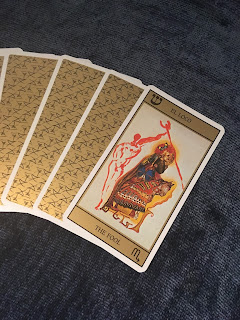Tarot Spreads for Story Structure
In high school, I was taught that every story follows the same plot formula: beginning, rising action, climax, falling action, end. They ingrained this pyramid image into my head. So maybe that’s why I have so much trouble constructing plots: because that basic formula isn’t all there is. It’s meant to be a simplified generalization of narrative, not an unbreakable rule.
One of my biggest issues with the narrative arc model is that the ending doesn’t imply a beginning. It’s a linear graph, not a circular one. But so many stories never end; they come full circle. Especially in character-driven narratives, the protagonist experiences a figurative rebirth or a return to the previous state of things, but changed.
To reflect this, I’ve created an alternative tarot spread for circular plots that focuses on protagonist development over the course of the story, which I call the Narrative Cycle. Below, I also include a spread for traditional narrative arcs.
The Narrative Cycle Spread
| The narrative cycle tarot spread |
Guide
- Core: The constant of your story. For character-driven narratives, this could be your protagonist. For conceptual stories, this may be the theme.
- Birth: This can be literal or figural. It’s the reader’s introduction to your protagonist.
- Conflict: The internal and/or external forces working on or within your protagonist. This can involve an antagonist, an inner battle, a catastrophe, loss, etc.
- Reaction: This focuses on your protagonist’s actions. How do they respond to the conflict? What steps do they take to resolve it?
- Change: Once your protagonist takes action against the conflict, it changes them for better or for worse.
- Rebirth: Metamorphosis implies a rebirth. Your protagonist is irrevocably changed. Now they must start over, renewed or broken down.
Notes
- If you pull a reversed card, this could mean your protagonist experiences a reversal of character--they may become the opposite of who they were, or even the antagonist of the story.
- If your story is the first in a series, the rebirth card may represent the beginning of the prequel.
- For tragedies, the change card may mean your protagonist’s death or the loss of all they hold dear. The rebirth card can then be the moment of catharsis.
The Narrative Arc Spread
If you prefer the traditional narrative arc model, you can add steps to the pyramid to give your plot spread more dimension. Try this:| The narrative arc tarot spread |
Guide
- Exposition: Introduce your readers to the world you’ve created and the characters that live there. Set a basis for all that will soon change.
- Inciting Incident: The catalyst of your story and the protagonist’s journey. Rising action starts here.
- Crisis: Something happens--a confrontation, a loss, a catastrophe. The rising action is close to a breaking point.
- Climax: The highest action point in the story. Everything has lead up to this moment.
- Denouement: The falling action. Things unravel.
- Resolution: Either the protagonist resolves the conflict, or deals with its fallout.
Notes
- If you’re structuring your story by acts, make sure that each act in the rising action ends in a climax that builds to the next one.
- For suspenseful stories like thrillers, psychological dramas, and horror, the twist happens in the climax of the story. These types of narratives usually have a false moment of clarity in the rising action and an unraveling of reality or previously held truths in the denouement.
- For tragedies, loss or death happens in the denouement when everything falls apart, and catharsis appears in the resolution.


Comments
Post a Comment